When summer approaches and temperatures soar, you might wonder how well cats can handle hot weather. Although even longhaired cats have some natural ways to cool down, it’s good to know what temperatures are too hot for cats, how to tell if your cat is too hot and what to do if your cat becomes overheated.
How Cats Stay Cool
Cats have special ways of cooling themselves naturally. Unlike dogs, cats rarely pant to cool off unless they are already overheated or suffering from heatstroke (if you see your cat panting, initiate cooling efforts immediately and contact your veterinarian for further instructions).
A cat’s coat uniquely keeps it warm in winter and cool in summer. The double coat has two layers—a longer outercoat and a shorter undercoat. The undercoat bulks up in winter, keeping the cat warm, but in summer the undercoat thins out so air can circulate down to the skin, keeping the cat cooler.
Can Cats Handle Hot Weather?
On hot days, cats seek out cool floor surfaces like tile and hardwood.
In hot weather, cats usually seek out cool surfaces to lie on and rest, which conserves their energy and keeps their body temperature as low as possible. Cats in the wild do this, too. In the baking savanna, lions find shade to lie down and sleep away the hottest part of the day. At home, you may see your cat lying on tile, concrete, hardwood, and linoleum.
Cats also cool themselves by grooming, which wets down the fur and helps lower the body temperature as the saliva evaporates. In the summer months, cats may also drink more water to cool down.
What Temperature Is Too Hot for Cats?
Even with these wonderful natural cooling techniques, cats can become overheated or even suffer from heatstroke on hot days. The exact temperature that’s too hot for a cat will vary depending on the individual. If you have air conditioning, set it to 78 degrees Fahrenheit to keep your indoor cat comfortable.
Limit your cat’s time outside during the hottest part of the day and save outings for early morning or dusk. Make sure outdoor cats have a shady spot to hang out.
Don’t forget, cats can get sunburn when they are outside, especially if they have thin coats or white coats. Never leave your cat in a car. Even on a mild sunny day, the temperature inside a car can soar to dangerous levels in minutes.
Keeping Cats Cool
Pet fountains can entice cats to drink more water to stay cooler and more hydrated.
Consider these easy tips for keeping your cat cool on summer days:
Air Conditioning
If you have an air conditioner, set it to 78 degrees Fahrenheit so your cat stays comfortable. Once the temperatures drop at night you can turn off the A/C and open windows to let the cooler night air in.
Fans
Use ceiling fans or place box fans or smaller tabletop fans in places where your cat likes to hang so she has a cool area to retreat to. Fans improve air circulation and keep the temperature cooler.
Fresh Water
Encourage your cat to drink more fresh water by putting extra water bowls in various parts of the house. Try dropping in some ice cubes to chill the water. Many cats also enjoy pet fountains that circulate water to keep it fresh and cool.
Close Curtains And Blinds
Keep your curtains and blinds drawn during the hottest parts of the day to block out the sun and heat, and to keep the inside of your house cooler.
Cooling Pet Mats
Consider investing in a special cooling mat, pad, or bed that’s designed to keep pets cool. This can be especially helpful if you don’t have cool floor surfaces like tile that your cat can lie on to cool off. You can also wrap a frozen water bottle in a towel so your cat has a cool place to lie on.
Brush Frequently
Brushing removes excess undercoat and allows your cat’s coat to cool the body naturally via air circulating down to the skin.
Overheating Danger Signs
If you think your cat is getting too hot, take swift action to help her cool down before she overheats.
Signs your cat may be overheating (hyperthermia) include acting sluggish or lethargic (or conversely, acting agitated and pacing), drooling, and panting. Heatstroke is a life-threatening condition.
Symptoms of heatstroke are the same as signs of overheating but may be more intense. A cat suffering from heatstroke may also vomit, have diarrhea, display bright red tongue and gums, experience breathing difficulties, and stagger or be unable to stand or walk.
If you think your cat is too hot, attempt to cool her down using fans or turning on the air conditioning, or by pouring room temperature water over her body to wet down your cat’s fur.
Don’t use cold water or ice, and don’t submerge your cat into a pool or bathtub of water, as this can drop the body temperature too suddenly and cause the cat to go into shock. While initiating cooling efforts, call your veterinarian or an emergency vet for further advice.
Frequently Asked Questions
Can cats handle hot weather?
Despite their fur coats, cats can handler warmer temperatures better than you might think. When brushed out regularly, a cat’s double-layered coat allows air to circulate down to the skin, which helps cool them off. In hot weather, cats lie on cool surfaces like tile, brick, concrete, hardwood and linoleum. This conserves energy and helps keep the body temperature lower. Cats may also drink more water and grooming themselves more, using their saliva to wets down the fur and help lower the body temperature.
How can I cool my cat down in hot weather?
If you have air conditioning, set it to 78 degrees to help your cat stay cool on warm days. You can also use fans, provide fresh water in dishes or a pet fountain, keep the curtains and blinds closed to block out the heat of the sun, and use special cooling pet mats or beds. If your cat seems like she is becoming overheated, you can pour room temperature water over the coat to help cool her off. Never use cold water or ice water, and don’t submerge your cat in a bath or pool of water. Cooling a cat too quickly can make her sick.
How can I tell if my cat is too hot?
If your cat is seeking out cool surfaces to lie and acting sluggish (or the opposite—agitated), she might be too hot. If you see signs of overheating or heatstroke, such as panting, drooling, vomiting, diarrhea, bright red tongue and gums, difficulty breathing, or staggering, start cooling efforts immediately and call your veterinarian right away.
What room temperature is too hot for cats?
Individual cats can tolerate different room temperatures. What might be too hot for one cat may be fine for another cat. Pay attention to your cat's behavior and watch for warning signs of overheating. If you have air conditioning, setting the temperature to 78 degrees Fahrenheit will keep your cat comfortable.
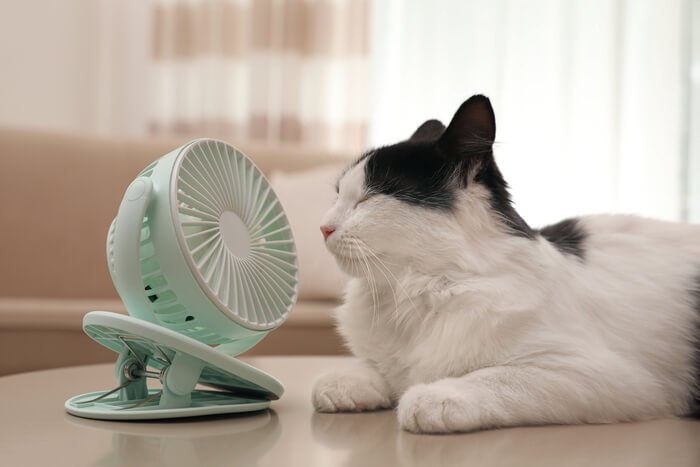
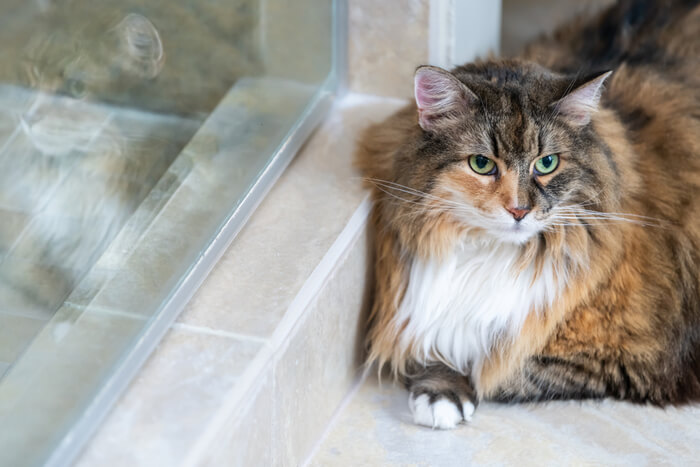
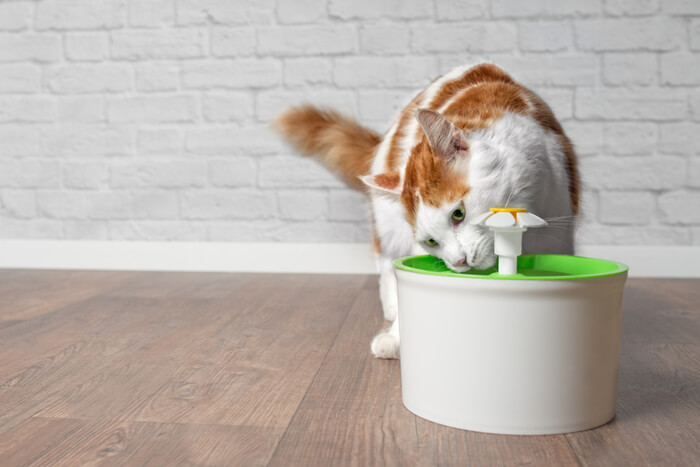
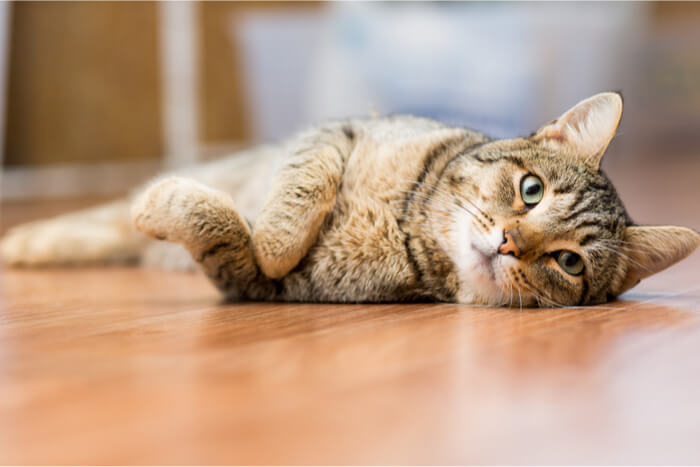

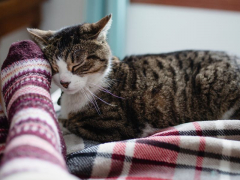
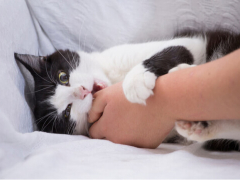


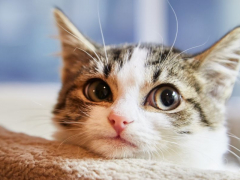


We have t te our cat to the vet to get spayed, but we d hav AC in the car and our weather some days go up to 80 or 90 degrees. What should we do? Would a cooling mat help? Thank You.
Hi there! Apologies for the late reply. I’d recommend cooling mats, sunshades on your window, and parking your car in a garage or shady area to prevent it from heating up too much before you leave. To prepare your cat, I’d think about gently brushing your cat with a damp comb to slightly wet their coat. Brushing beforehand will also help to remove some of that thick, hot undercoat and help them to feel cooler. Be sure to provide some water in your cat’s carrier and open the windows when possible. Hope this helps!
Sorry I messed up on the spelling. I meant to say We are taking our cat to get spayed. We don’t have AC in our car and the weather some days go up to 80 or 90 degrees. What should we do? would a cooling mat help. Thank You.
That’s okay! I just responded to your original comment.